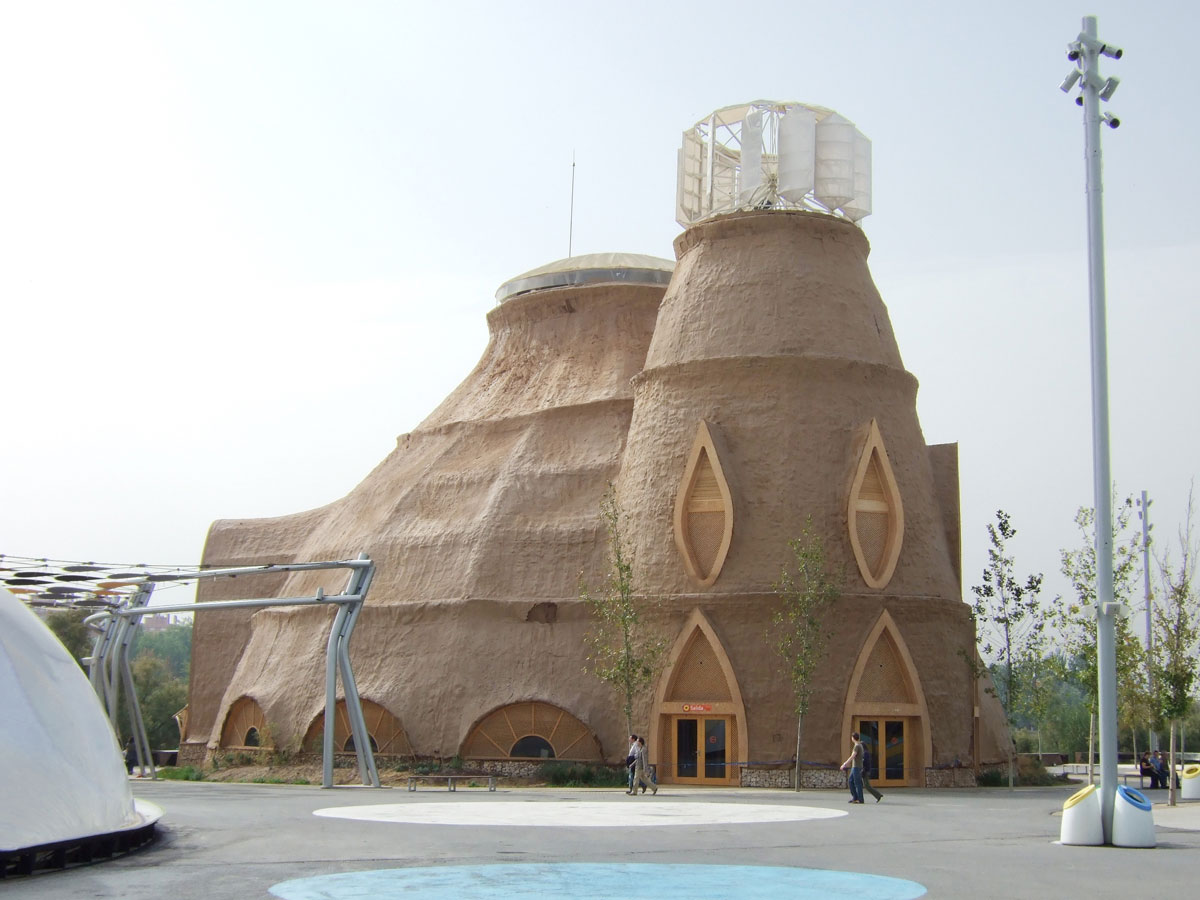Architecture sometimes produces the most adventurous blossoms:
The 25 m high El Faro made of prefabricated clay plastered straw bale walls on a wooden framework was erected on the occasion of the Expo 2008 in Zaragoza, an adventurous undertaking, as the pictures show…
The official description says: “The pavilion is based on energy efficiency, recycling and sustainability. Both – the construction form and its use – are based on the (evaporation/cooling) principle of the traditional clay jug. Only natural materials such as straw, wood and clay were used.
Straw not only stands for its degree of biodegradability, it is easy to recycle, and since it grows back in a short time, also for the flexibility of its use. Straw bales insulate 200 times better than conventional bricks and are therefore predestined for cooling the building.
Clay is one of the oldest building materials, especially for dry areas.
In addition to the ecological advantages of the building materials, El Faro uses the river Ebro, the sun, the air, the humidity kit and geothermal energy for the energy technology of the building.
More pictures of the construction: The official description says: “The pavilion is based on energy efficiency, recycling and sustainability. Both – the construction form and its use – are based on the (evaporation/cooling) principle of the traditional clay jar. Only natural materials such as straw, wood and clay were used.
Straw not only stands for its degree of biodegradability, it is easy to recycle, and since it grows back in a short time, also for the flexibility of its use. Straw bales insulate 200 times better than conventional bricks and are therefore predestined for cooling the building.
Clay is one of the oldest building materials, especially for dry areas.
In addition to the ecological advantages of the building materials, El Faro used the river Ebro, the sun, the air, the humidity kit and geothermal energy for the energy technology of the building.
Die Architektur treibt manchmal die abenteuerlichsten Blüten:
Der 25 m hohe El Faro aus vorgefertigten lehmverputzten Strohballenwänden auf Holzständergerüst wurde anlässlich der Expo 2008 in Saragossa errichtet, ein abenteuerliches Unterfangen, wie die Bilder zeigen…
In der offiziellen Beschreibung heißt es: Der Pavillon basiert auf Energieeffizienz, Recycling und Nachhaltigkeit. Beides – die Bauform wie seine Verwendung – basieren auf dem (Verdunstungs-/Kühlungs-)Prinzip des traditionellen Tonkrugs. Es wurden ausschließlich natürliche Materialien wie Stroh, Holz und Lehm verwendet.
Stroh steht nicht nur für seinen Grad an biologischer Abbaubarkeit, es ist leicht zu recyceln, und da es in kurzer Zeit nachwächst, auch für die Flexibilität seiner Verwendung. Strohballen isolieren 200mal besser als konventionelle Ziegel und sind deshalb für die Kühlung des Gebäudes prädestiniert.
Lehm ist einer der ältesten Baustoffe insbesondere für trockene Gegenden.
Zusätzlich zu den ökologischen Vorteilen der Baumaterialien nutzt El Faro den Fluss Ebro, die Sonne, die Luft, die Luftfeuchtigekit und geothermische Energie für die Energietechnik des Gebäudes.
Mehr Bilder zur Konstruktion: In der offiziellen Beschreibung heißt es: Der Pavillon basiert auf Energieeffizienz, Recycling und Nachhaltigkeit. Beides – die Bauform wie seine Verwendung – basieren auf dem (Verdunstungs-/Kühlungs-)Prinzip des traditionellen Tonkrugs. Es wurden ausschließlich natürliche Materialien wie Stroh, Holz und Lehm verwendet.
Stroh steht nicht nur für seinen Grad an biologischer Abbaubarkeit, es ist leicht zu recyceln, und da es in kurzer Zeit nachwächst, auch für die Flexibilität seiner Verwendung. Strohballen isolieren 200mal besser als konventionelle Ziegel und sind deshalb für die Kühlung des Gebäudes prädestiniert.
Lehm ist einer der ältesten Baustoffe insbesondere für trockene Gegenden.
Zusätzlich zu den ökologischen Vorteilen der Baumaterialien nutzte El Faro den Fluss Ebro, die Sonne, die Luft, die Luftfeuchtigekit und geothermische Energie für die Energietechnik des Gebäudes.
*El Faro wurde nach der Expo abgetragen.

